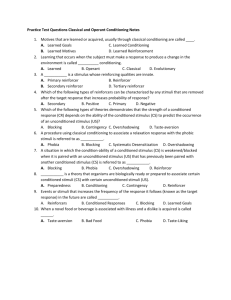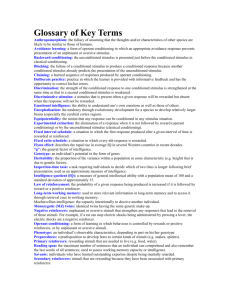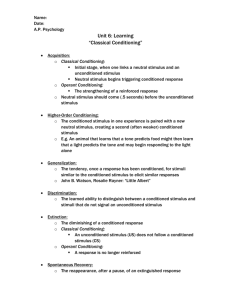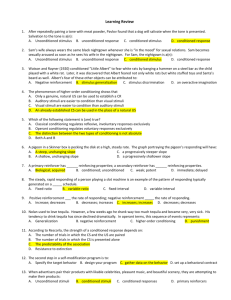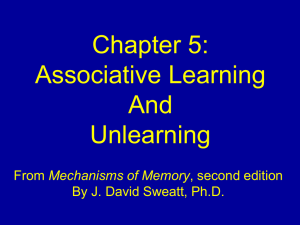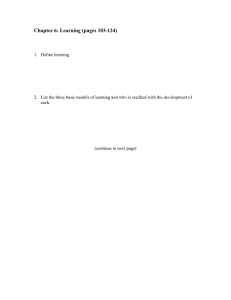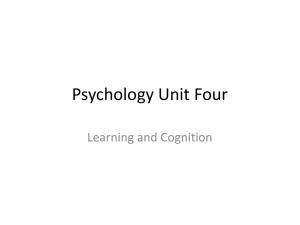Learning Processes: Exam Questions & Answers
advertisement
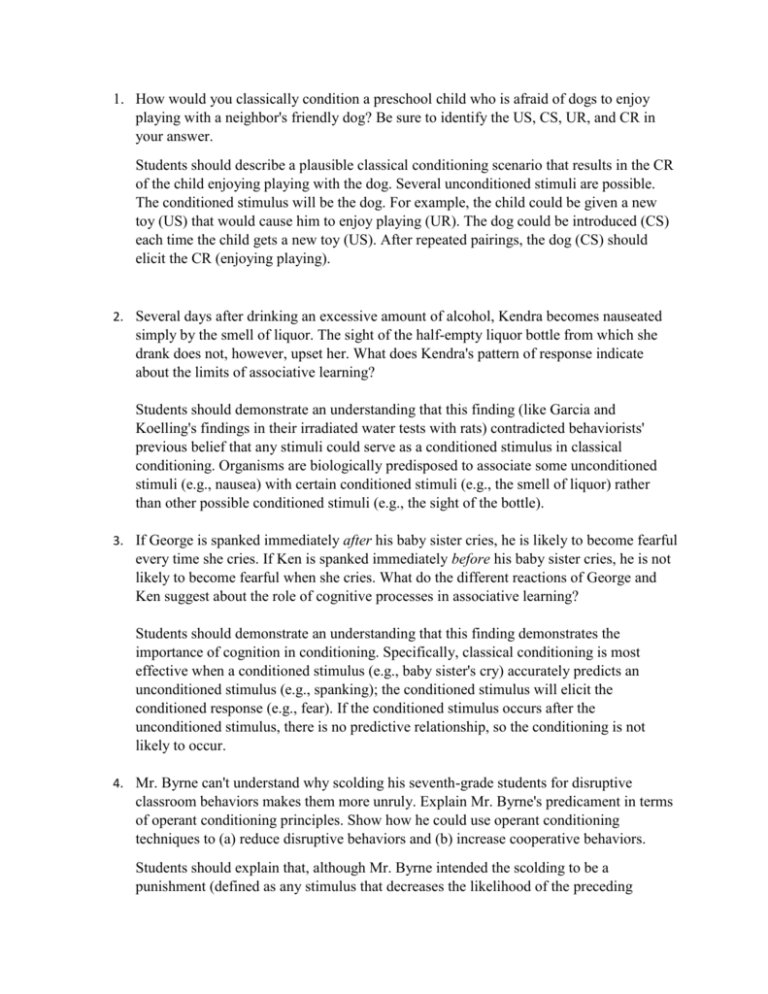
1. How would you classically condition a preschool child who is afraid of dogs to enjoy playing with a neighbor's friendly dog? Be sure to identify the US, CS, UR, and CR in your answer. Students should describe a plausible classical conditioning scenario that results in the CR of the child enjoying playing with the dog. Several unconditioned stimuli are possible. The conditioned stimulus will be the dog. For example, the child could be given a new toy (US) that would cause him to enjoy playing (UR). The dog could be introduced (CS) each time the child gets a new toy (US). After repeated pairings, the dog (CS) should elicit the CR (enjoying playing). 2. Several days after drinking an excessive amount of alcohol, Kendra becomes nauseated simply by the smell of liquor. The sight of the half-empty liquor bottle from which she drank does not, however, upset her. What does Kendra's pattern of response indicate about the limits of associative learning? Students should demonstrate an understanding that this finding (like Garcia and Koelling's findings in their irradiated water tests with rats) contradicted behaviorists' previous belief that any stimuli could serve as a conditioned stimulus in classical conditioning. Organisms are biologically predisposed to associate some unconditioned stimuli (e.g., nausea) with certain conditioned stimuli (e.g., the smell of liquor) rather than other possible conditioned stimuli (e.g., the sight of the bottle). 3. If George is spanked immediately after his baby sister cries, he is likely to become fearful every time she cries. If Ken is spanked immediately before his baby sister cries, he is not likely to become fearful when she cries. What do the different reactions of George and Ken suggest about the role of cognitive processes in associative learning? Students should demonstrate an understanding that this finding demonstrates the importance of cognition in conditioning. Specifically, classical conditioning is most effective when a conditioned stimulus (e.g., baby sister's cry) accurately predicts an unconditioned stimulus (e.g., spanking); the conditioned stimulus will elicit the conditioned response (e.g., fear). If the conditioned stimulus occurs after the unconditioned stimulus, there is no predictive relationship, so the conditioning is not likely to occur. 4. Mr. Byrne can't understand why scolding his seventh-grade students for disruptive classroom behaviors makes them more unruly. Explain Mr. Byrne's predicament in terms of operant conditioning principles. Show how he could use operant conditioning techniques to (a) reduce disruptive behaviors and (b) increase cooperative behaviors. Students should explain that, although Mr. Byrne intended the scolding to be a punishment (defined as any stimulus that decreases the likelihood of the preceding behavior), it must be acting as a positive reinforcer (defined as any stimulus that increases the likelihood of the preceding behavior). Mr. Byrne needs to try different stimuli until he finds one that decreases the disruptive behaviors (a punishment), and a stimulus that increases the cooperative behaviors (positive reinforcement). 5. For Vina, cigarettes reduce feelings of tension and anxiety. Because of her heavy smoking, however, she has a bad morning cough and breathing difficulties. How can the principles of operant conditioning help to explain the development and continuation of Vina's self-defeating smoking habit? Explain the extent to which the reinforcement for Vina's habit is positive or negative, primary or conditioned, immediate or delayed, partial or continuous. Students should explain Vina's smoking behavior as continuing because the side effects of smoking (e.g., the stimulant effects of nicotine, such as stress relief, a sense of wellbeing, alertness, and decreased appetite) outweigh her health impairments (a bad morning cough and breathing difficulties). In the discussion, students should correctly identify a positive reinforcement (such as a feeling of alertness) or a negative reinforcement (reduction of stress) that occurs after the smoking behavior. These reinforcements are most likely to be primary reinforcers (because they are likely to be physiological), but students could describe some secondary (learned) reinforcers (such as “looking cool”). The reinforcers described are likely to be immediate (occurring directly after the behavior) rather than delayed and continuous (one reinforcer delivered per behavior) rather than partial. 6. Although Mr. Wright often tells his children about the importance of donating time and money to charitable causes, he rarely does so himself. He believes that this hypocrisy will not rub off on his children, however, as long as he has plausible excuses for his lack of charity. Use your understanding of learning processes to explain how Mr. Wright's children are likely to be affected by their father's behavior. What advice would you give to Mr. Wright? Students should explain that observational learning theory predicts that Mr. Wright's children will imitate both his actions and his excuses. Observational learning studies indicate that observational learning will occur most powerfully when the actions and words of models are consistent; when models do one thing and say another, children will do what they see adults do and say what they hear adults say. Students should advise Mr. Wright to provide an effective model to his children by actually donating time and money to charity and continuing by talk about why this is important. This model is more likely to increase the chances of his children learning this behavior through observational learning.


